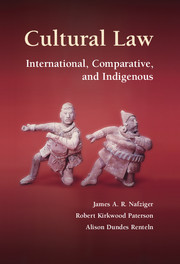52 results
Meeting of the Cultural Heritage Law Committee of the International Law Association: 10 August 2016, Johannesburg, South Africa
-
- Journal:
- International Journal of Cultural Property / Volume 24 / Issue 1 / February 2017
- Published online by Cambridge University Press:
- 14 March 2017, pp. 101-102
-
- Article
- Export citation
The Assault on International Law. By Jens David Ohlin. Oxford, New York: Oxford University Press, 2015. Pp. xiii, 289. Index. $29.95.
-
- Journal:
- American Journal of International Law / Volume 110 / Issue 1 / January 2016
- Published online by Cambridge University Press:
- 20 January 2017, pp. 142-148
- Print publication:
- January 2016
-
- Article
- Export citation
The Draft Convention on Immunity from Suit and Seizure for Cultural Objects Temporarily Abroad for Cultural, Educational or Scientific Purpose
-
- Journal:
- International Journal of Cultural Property / Volume 21 / Issue 4 / November 2014
- Published online by Cambridge University Press:
- 22 January 2015, pp. 481-498
-
- Article
- Export citation
Underwater Cultural Heritage and International Law. By Sarah Dromgoole. 400 pp. Cambridge University Press, 2013.
-
- Journal:
- International Journal of Cultural Property / Volume 21 / Issue 2 / May 2014
- Published online by Cambridge University Press:
- 26 June 2014, pp. 225-230
-
- Article
- Export citation
ASIL Annual General Meeting
-
- Journal:
- Proceedings of the ASIL Annual Meeting / Volume 106 / 2012
- Published online by Cambridge University Press:
- 28 February 2017, pp. 579-580
- Print publication:
- 2012
-
- Article
- Export citation
The Cultural Heritage Law Committee of the International Law Association: General Session, August 16, 2010: The Hague, The Netherlands
-
- Journal:
- International Journal of Cultural Property / Volume 17 / Issue 4 / November 2010
- Published online by Cambridge University Press:
- 21 February 2011, p. 661
-
- Article
- Export citation
ASIL Annual General Meeting
-
- Journal:
- Proceedings of the ASIL Annual Meeting / Volume 105 / 2011
- Published online by Cambridge University Press:
- 28 February 2017, pp. 599-600
- Print publication:
- 2011
-
- Article
- Export citation
Acknowledgments
-
- Book:
- Cultural Law
- Published online:
- 05 June 2012
- Print publication:
- 01 November 2010, pp xxvii-xxviii
-
- Chapter
- Export citation
10 - Language and Linguistic Expression
-
- Book:
- Cultural Law
- Published online:
- 05 June 2012
- Print publication:
- 01 November 2010, pp 915-980
-
- Chapter
- Export citation
Preface
-
-
- Book:
- Cultural Law
- Published online:
- 05 June 2012
- Print publication:
- 01 November 2010, pp xxiii-xxvi
-
- Chapter
- Export citation

Cultural Law
- International, Comparative, and Indigenous
-
- Published online:
- 05 June 2012
- Print publication:
- 01 November 2010
4 - Cultural Material: Protection and Cooperation
-
- Book:
- Cultural Law
- Published online:
- 05 June 2012
- Print publication:
- 01 November 2010, pp 252-388
-
- Chapter
- Export citation
1 - Cultural Law: An Introduction
-
- Book:
- Cultural Law
- Published online:
- 05 June 2012
- Print publication:
- 01 November 2010, pp 1-99
-
- Chapter
-
- You have access
- Export citation
Index
-
- Book:
- Cultural Law
- Published online:
- 05 June 2012
- Print publication:
- 01 November 2010, pp 981-1012
-
- Chapter
- Export citation
5 - Cultural Material: Rectification, Criminal Justice, and Dispute Resolution
-
- Book:
- Cultural Law
- Published online:
- 05 June 2012
- Print publication:
- 01 November 2010, pp 389-613
-
- Chapter
- Export citation
6 - Intangible Cultural Heritage
-
- Book:
- Cultural Law
- Published online:
- 05 June 2012
- Print publication:
- 01 November 2010, pp 614-673
-
- Chapter
- Export citation
Frontmatter
-
- Book:
- Cultural Law
- Published online:
- 05 June 2012
- Print publication:
- 01 November 2010, pp i-iv
-
- Chapter
- Export citation
Contents
-
- Book:
- Cultural Law
- Published online:
- 05 June 2012
- Print publication:
- 01 November 2010, pp v-xxii
-
- Chapter
- Export citation
2 - Culture and Law: The Basics
-
- Book:
- Cultural Law
- Published online:
- 05 June 2012
- Print publication:
- 01 November 2010, pp 100-205
-
- Chapter
- Export citation
8 - Sports
-
- Book:
- Cultural Law
- Published online:
- 05 June 2012
- Print publication:
- 01 November 2010, pp 740-830
-
- Chapter
- Export citation

